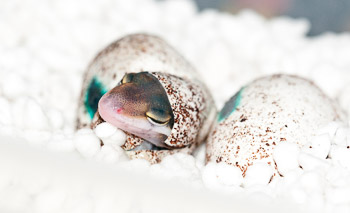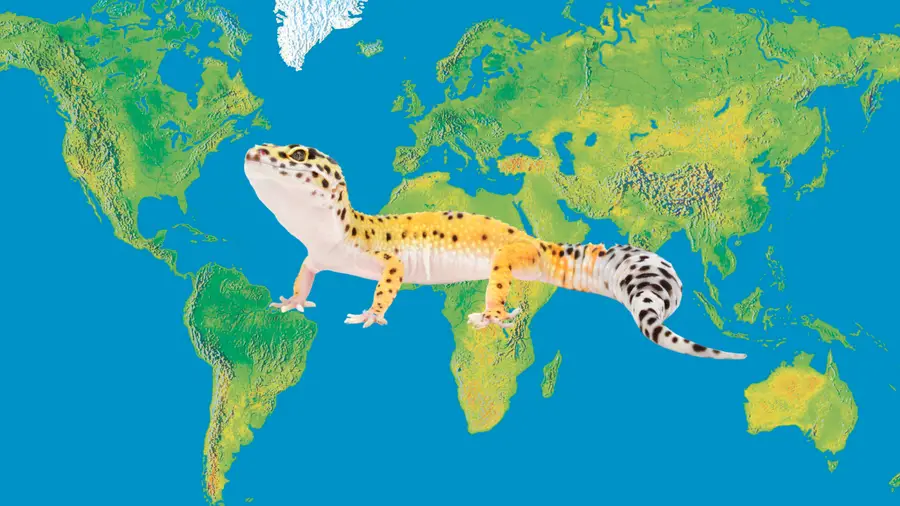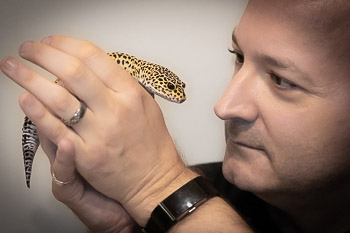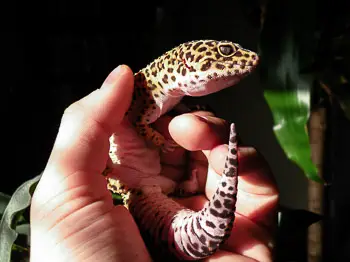Leopard Geckos are one of the most popular pet reptiles. Seeing them in pet stores, I always wonder where they are sourced from.
Where do leopard geckos come from? Wild leopard geckos can be found in the desert regions of Iraq, Iran, India, and Afghanistan. Pet leopard geckos are sourced primarily from reptile mills where they are sold en mass to pet stores, or from local breeders.

Leopard Geckos in the Wild
Leopard geckos in the wild are found primarily in the deserts of the Middle East, namely Iran, Iraq, Afghanistan, and Northern India. They thrive in dry and arid climates and live in areas with rocky crags, and dry grasslands.
When imagining the leopard gecko’s natural habitat, think less endless sand dunes and more rocks and scrub brush.


A small lizard, this little guy grows between 7 to 8 inches long with slits for pupils. Common leopard geckos have darker spots on a creamy yellowish background, resembling the coloring and patterns of a leopard. Leopard geckos have leathery skin as opposed to scales and have segmented tails, making leopard geckos resemble tiny crocodiles.
They are crepuscular , meaning most active at dawn and dusk. During they day they’ll hide in burrows or the clefts in the rocks, only to emerge to forage for food in the evening when the heat is more temperate. (Read more in our post: Are Leopard Geckos Nocturnal?)
Because leopard geckos in the wild come from warm, arid desert areas, they can become quite sluggish in colder weather. If the winter temperatures drop for a sustained period of time, wild leopard geckos will sometimes go dormant during the coldest part of the winter. They enter a state of semi hibernation called brumation. They will live off of the fat stored in their tails as their metabolism slows down.
Amazingly, this hearty lizard can live up to 15 years in the wild. That is, if they’re not picked off by predators.
Wild leopard geckos are more prone to illness than their bred-in-captivity counterparts. This is likely due to uncertain water sources and a lack of normal feeding schedules. Coming in contact with ill creatures is also more likely in the wild. These are all factors your pet leopard gecko shouldn’t have to worry about.
Leopard Geckos Bred in Captivity
Leopard geckos have been imported from their natural habitat and bred as pets for over three decades. This has made them one of the more popular breeds of lizards to own today. Most, if not all, leopard geckos for in the pet trade are bred in captivity and not taken from their native habitat.

Some geckos and other lizards have been bred in reptile mills in order to sell mass quantities of them. Quite often, these geckos are purchased by chain pet stores. Reptiles from these mills can be prone to poor health as they are bred in poor conditions.
That is why many folks who wish to own a leopard gecko go to reputable commercial breeders instead. There are several benefits of doing so, the first of which being these breeders care about the geckos they breed. For them, it’s less about moving product, and more about being a responsible breeder.
Also, these breeders have the ability to crossbreed their geckos, which allows for many colorful and amazing morphs. Morphs are like designer geckos that have different coloring and patterns than the “normal” yellow with black spots leopard gecko. If you’re looking for a particular kind of morph in your leopard gecko, these breeders might be able to help. Not only that, purchasing a lizard from a commercial breeder helps sustain an ethical business.
Benefits of Choosing a Commercial Breeder
Unlike buying your gecko at the local chain pet store, buying from a commercial breeder allows you to know exactly where your lizard came from. Not only that, you will be able to trace their lineage and genetics. This is vital for differing morphs.
Related Post: Find out the science behind how morphs are bred in our post on leopard gecko genetics.
These breeders also know well how to properly care for leopard geckos. Their animals are usually guaranteed to be healthy, as they are not bred simply by the numbers, but by the health of the parents and by any specific coloring and genetic traits. This means more care will be taken in choosing which lizards to breed to ensure healthy offspring.
Breeders also care about whether or not your pet arrives alive. Most do not ship their leopard geckos close to or on the weekends, and use premium shipping choices. This means their prime shipping days are Mondays, Tuesdays, and Wednesdays and your pet isn’t in transit any longer than necessary.
They will also make sure the packaging is cozy and well-insulated for the lizards, to guarantee safe delivery.
Which Commercial Breeder to Choose?
There are several different breeders from which to choose, and these breeders take their craft very seriously. You’ll know exactly where your leopard gecko came from and why they were bred. This list includes:
- CBReptile – A reputable breeder with a wide variety of morphs available online. We’re an affiliate, and you can find their available leopard geckos here. CBReptile also has supplies available if you need anything for your gecko.
- Ron Temper – A Pioneer in morphs, Ron Tremper was the first to breed albino geckos.
- Geckos ETC – Specializes in unique and often rare leopard geckos.
- Geckoboa – Boasts the most diverse pure Eublepharis species in the world.
- JMG Reptile – Specializes in Bold Hyper Xanthic and the JMG Sun Glow lines.
- Fire n’ Ice Geckos – Well-known for their crosses of Black Nights and Snows.
Related Post: Check out our Leopard Gecko Breeding Guide and see what it takes to breed your own geckos!
Keeping leopard geckos in captivity
Leopard geckos tend to live longer in captivity. They are typically kept in a controlled environment with regulated temperatures and little exposure to disease. Pet geckos receiving proper care have a regular source of food and are not at risk to predators. Where a leopard gecko may live 15 years in the wild, it is common for pet leopard geckos to live 20 years. Some have been reported to live as long as 30 years! You can read more in our post about leopard gecko longevity.
Wrap up – Where do Leopard Geckos Come From?
Leopard geckos originate from Middle Eastern desert regions, though pet leopard geckos are typically bred in captivity. The leopard geckos you’d buy are either mass bred for wide distribution, or produced by private breeders.
Make sure you have everything you need for your leopard gecko habitat and visit our HABITAT SETUP Page.





